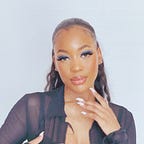the changing face of beauty
The painful nature of beauty has long existed in cultures around the world. Women have always been subjected to archaic concepts of beauty throughout time. Steel boned corsets and 30 kilogram dresses, bound feet and damaged skin from bleaching creams are just a few examples of how the constructs of beauty have physically impaired femme bodies. As the stage of social media continues to develop, the ways that subcultures interact with the new face of beauty is becoming clear. Racialised aesthetics on the social media marketplace have constructed a new cyborg face. As Jia Tolentino so aptly puts it: “the face is distinctly white but ambiguously ethnic…a young face, of course, with poreless skin and plump, high cheekbones. It has catlike eyes and long, cartoonish lashes; it has a small, neat nose and full, lush lips.”
This face, modelled after the infamous Kardashian-Jenner clan and the thousands of slim, beautiful supermodels after her, have shaped much of the beauty culture in current discussions on beauty. Tiktok’s popularity has diversified and globalised micro beauty trends: dyson airwrap “effortless” curls, clean beauty, minimal coverage makeup looks and vegan cruelty free skincare. Despite these trends diverging from the instagram glam of the twenty ten’s and somewhat embracing natural and realistic skin, they are still based on an understanding that beauty = capital. As social media beauty trends move past the perfectionism associated with the Kardashians, it engages in another form of perfection, through the supermodel body that was ever so popular in the noughties. Tiktok’s algorithm pushes stereotypically beautiful creators who engage in these trends, what they all have in common? Features of the cyborg face. It would be inaccurate if I did not mention the ways that the Kardashians have dictated trends and shaped the discourse on modern bodies thus far, but as fashion and fitness trends develop online, and new levels of thinness rise to popularity, we see a new type of body being placed at the centre of beauty and desire. A very thin, very white one. Yes, Tolentino is correct in naming the ways instagram filters are moulded after the famous family, and yes they were the source of inspiration for a constantly changing, yet always perfect face and body. However, as trends have progressed and body modificiation is now sold in a subtle and discreet package, audiences are being told that this new thin body is an achievable consumer experience. You too can have a supermodel body, and if you try hard enough, it may even catapault you to online socialite celebrity status.
The ever changing faces of these supermodels are examples of the growing relationship between women and the perfect cyborg being. Freezing the face is no longer a dream, it has been made possible through surgery and fillers. As Acetti says, “botox and aesthetic surgery freeze and paralyse the face in a fixed expression of joy and youth” placing importance on the aesthetics of youth, agelessness and endless beauty — all deeply connected and commodified in the influencer space.
The modern body continues to change. The interconnectedness of social media dictates how we can achieve capital through our bodies. There is little discussion on the material consequences of this all-encompassing desire for beauty capital and the ability to negotiate social power. With the resurgence of y2k fashion came the flat stomachs and tiny frames of the models who wore these clothes in the 2000’s. The models who wear and popularise this fashion today (think the Hadid’s, Kendall Jenner and Hailey Beiber) show the glamorous side of the noughties whilst ignoring the eating disorders, drug abuse and depression that plagued ultra thin models of that era. Can we embrace one part of this era without acknowledging the other?
Lanfranco Acetti — The Normalization of the cyborg
Dolly Kumar — Cyborg Fashion
